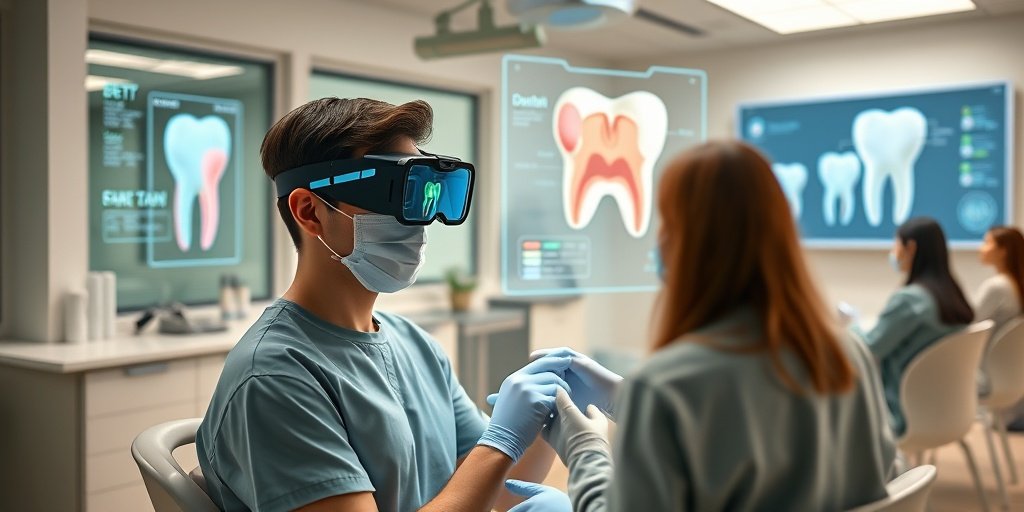⚡ Quick Summary
The integration of artificial intelligence (AI) and augmented reality (AR) in dental education is revolutionizing the way students develop clinical skills. These technologies enhance learning experiences, improve diagnostic accuracy, and streamline administrative tasks, paving the way for a more effective educational framework.
🔍 Key Details
- 📊 Technologies: Artificial Intelligence (AI) and Augmented Reality (AR)
- 🧩 Applications: Diagnostics, treatment planning, patient management, and educational tools
- ⚙️ AI Subfields: Machine learning, artificial neural networks, computational vision, robotics, and speech processing
- 🏆 AR Applications: Simulation and training, patient education, endodontics, implantology, and local anesthetic training
🔑 Key Takeaways
- 🤖 AI enhances diagnostics and treatment planning in dental education.
- 🕶️ AR provides immersive learning experiences through simulations.
- 📈 Personalized learning is made possible with AI technologies.
- 🏥 Risk-free environments for skill development are created using AR simulations.
- 🌍 Standardized training across institutions is facilitated by these technologies.
- 💰 Challenges include high implementation costs and faculty training needs.
- 🔮 Future potential includes transforming dental curricula and improving patient care.

📚 Background
The field of dental education is undergoing a significant transformation with the advent of AI and AR technologies. These innovations are not only enhancing the way students learn but also improving the overall quality of dental care. Traditional methods of training often lack the interactive and personalized elements that modern technology can provide, making the integration of AI and AR crucial for the future of dental education.
🗒️ Study
The article discusses the current applications and future potential of AI and AR in dental education, highlighting how these technologies can be utilized to enhance clinical skills acquisition. The authors explore various AI subfields and their contributions to diagnostics and treatment planning, as well as the immersive experiences offered by AR in training scenarios.
📈 Results
The integration of AI and AR in dental education has shown promising results, including improved diagnostic accuracy and enhanced learning experiences. AR-based simulations allow students to practice procedures on virtual patients, receiving real-time feedback that is invaluable for skill development. These advancements contribute to a more effective and engaging learning environment.
🌍 Impact and Implications
The implications of integrating AI and AR into dental education are profound. As these technologies continue to evolve, they promise to not only enhance educational outcomes but also improve patient care. By providing students with the tools to learn in a risk-free environment, we can expect a new generation of dental professionals who are better equipped to meet the challenges of modern healthcare.
🔮 Conclusion
The integration of AI and AR in dental education represents a significant leap forward in how clinical skills are taught and refined. With the potential to transform curricula and improve patient outcomes, these technologies are set to play a crucial role in the future of dental training. Continued research and investment in these areas will be essential to fully realize their benefits.
💬 Your comments
What are your thoughts on the integration of AI and AR in dental education? We would love to hear your insights! 💬 Leave your comments below or connect with us on social media:
The Integration of Artificial Intelligence and Augmented Reality in Dental Education: Current Applications and Future Potential.
Abstract
The integration of artificial intelligence (AI) and augmented reality (AR) in dental education is transforming how students acquire and refine clinical skills. This article explores current applications and the future potential of AI and AR in dental training. AI, defined as the simulation of human cognitive functions by machines, enhances diagnostics, treatment planning, patient management, and educational tools through subfields like machine learning, artificial neural networks, computational vision, robotics, and speech processing. These technologies enable personalized learning, can improve diagnostic accuracy, and streamline administrative tasks. AR, which overlays digital information onto real-world components, provides immersive and interactive learning experiences. In dental education, AR-based simulations enable risk-free environments for skill development, allowing students to practice procedures on virtual patients with real-time feedback. Applications of AR include simulation and training, patient education, endodontics, implantology, and local anesthetic training. These tools help enhance spatial understanding, reduce learning curves, and facilitate standardized training across institutions. Despite challenges such as high implementation costs and the need for faculty training, the potential benefits of AI and AR in dental education are significant. As these technologies continue to evolve, they promise to transform dental curricula, improve educational outcomes, and, ultimately, enhance patient care.
Author: [‘Perry R’, ‘Singh G’, ‘Dame A’, ‘Mohamed SA’, ‘Idiculla AM’, ‘Garg R’]
Journal: Compend Contin Educ Dent
Citation: Perry R, et al. The Integration of Artificial Intelligence and Augmented Reality in Dental Education: Current Applications and Future Potential. The Integration of Artificial Intelligence and Augmented Reality in Dental Education: Current Applications and Future Potential. 2025; 46:216-222.